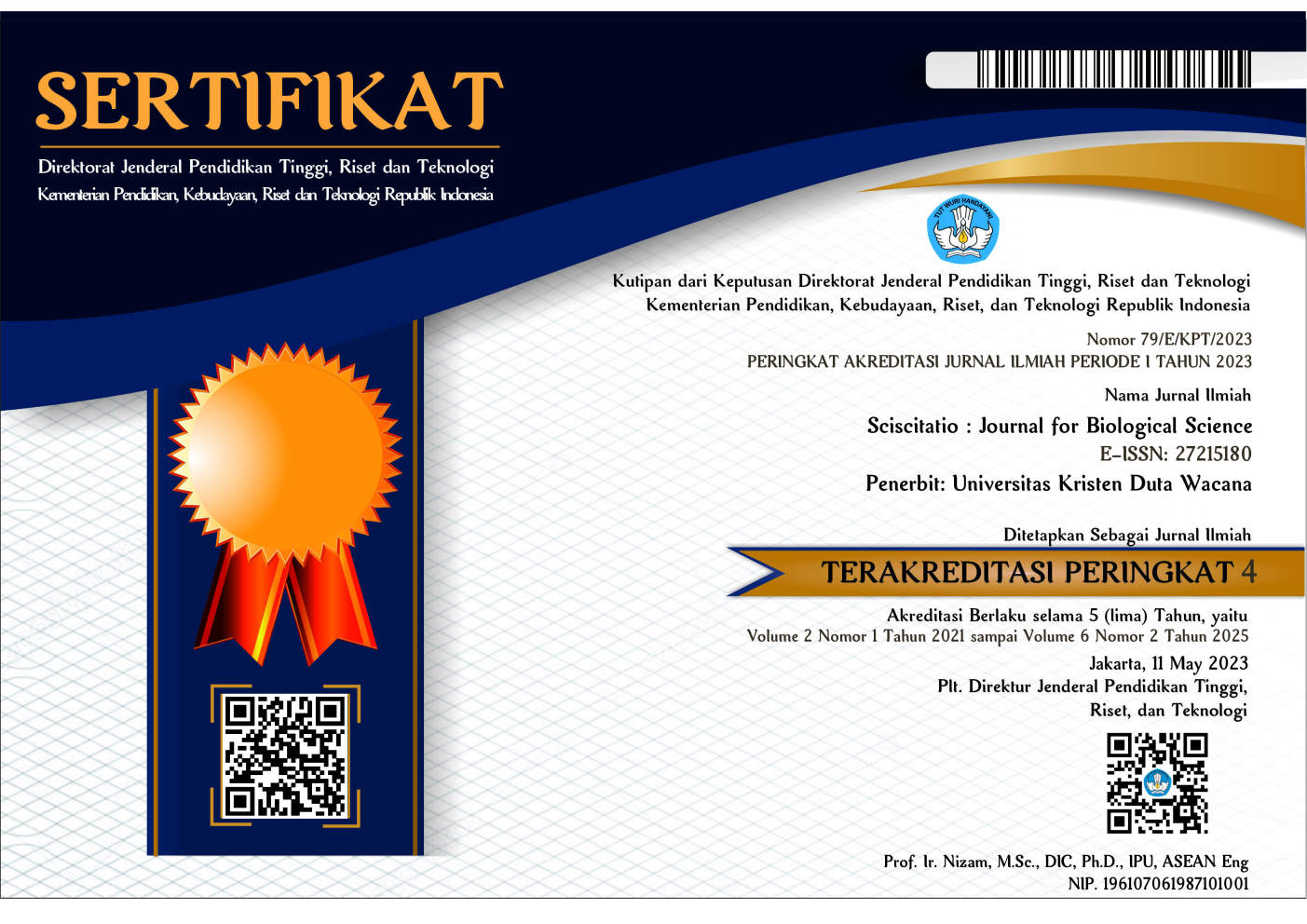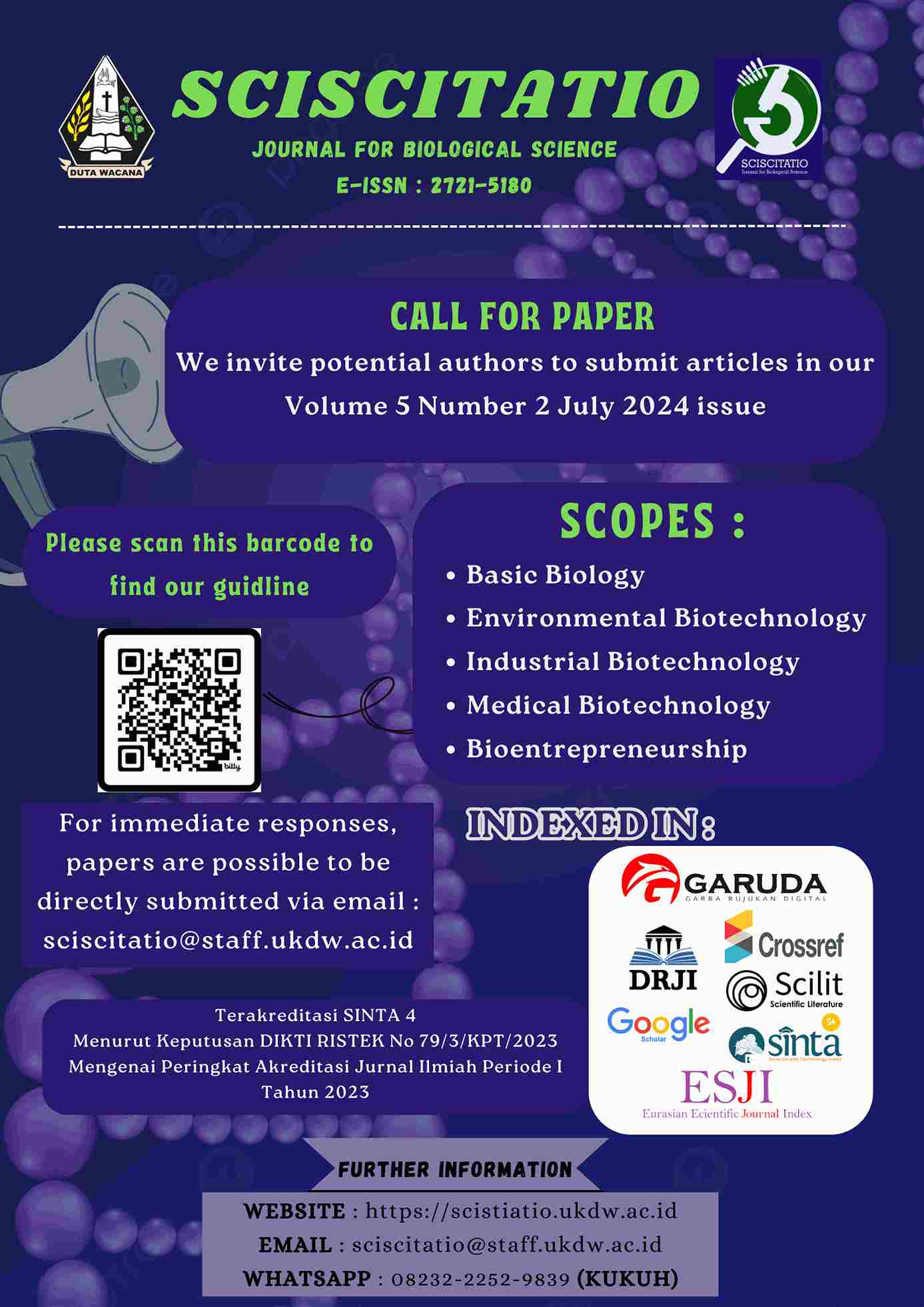Uji Antibakteri Rhizopus sp. Asal Inokulum Tempe terhadap Vibrio cholerae
DOI:
https://doi.org/10.21460/sciscitatio.2021.22.72Keywords:
Rhizopus sp. antibakteri, tempe, Vibrio choleraeAbstract
Rhizopus sp. merupakan kapang yang digunakan dalam fermentasi tempe. Kapang Rhizopus pada
tempe telah dikaji manfaatnya dalam mengurangi kejadian diare pada Escherichia coli dan Salmonella typhi
dibandingkan pada Vibrio cholerae. Diare kolera yang disebabkan oleh Vibrio cholerae pernah menjadi Kejadian
Luar Biasa (KLB) di Indonesia, sehingga bakteri kolera sebagai penyebab penyakit pada penderita diare
masih ada. Penelitian ini bertujuan untuk mengetahui kemampuan antibakteri Rhizopus sp asal inokulum
tempe terhadap Vibrio cholerae dan mengetahui perbedaan kemampuan antibakteri Rhizopus sp dari beberapa
inokulum tempe terhadap Vibrio cholerae. Uji antibakteri Rhizopus sp terhadap Vibrio cholerae dilakukan
dengan metode difusi kertas. Isolasi dari inokulum tempe komersial memperoleh dua isolat kapang, yang
teridentifikasi Rhizopus sp.IP dan Rhizopus sp. IJ. Hasil uji antibakteri menunjukkan bahwa dua isolat Rhizopus
sp. tersebut dapat menghambat Vibrio cholerae. dengan kemampuan penghambat kategori sedang dan tidak
terdapat perbedaan aktivitas antibakteri Rhizopus sp. IP dan Rhizopus sp. IJ terhadap Vibrio cholerae.
References
Babu, P. D., Bhakyaraj, R., & Vidhyalakshmi, R. (2009). A Loa Cost Nutritious Food Tempe. World Journal of Diary and Food Sciences, 4(1), 22–27.
Barus, T., Maya, F., & Hartanti, A. T. (2019). Peran Beberapa Galur Rhizopus microsporus yang Berasal dari “laru tradisional” dalam Menentukan Kualitas Tempe. Jurnal Aplikasi Teknologi Pangan, 8(1), 17–22. doi.org/10.17728/ jatp.3761
Brooks, G. F., Carroll, K. C., Butel, J. s, Morse, S. A., & Mietzner, T. A. (2012). Jawetz, Melnick, & Adelberg Mikrobiologi Kedokteran (25th ed.; A. Adityaputri, C. Salim, F. Sandra, M. Iskandar, Nalurita, P. Ayuningtyas, S. Debby, Eds.). Jakarta: Penerbit Buku Kedokteran EGC.
CLSI. Clinical And Laboratory Standarts Institute (2002). Performance Standards for Antimicrobial Disk and Dilution Susceptibility Tests for Bacteria Isolated from Animals; Approved Standard — Second Edition.
Davis, W. W., & Stout, T. R. (1971). Disc Plate Method of Microbiological Antibiotic Assay. Applied Microbiology, 22(4), 666– 670. doi.org/10.1128/aem.22.4.666- 670.1971
Dewi, R. S., & Aziz, S. (2011). Isolasi Rhizopus oligosporus pada Beberapa Inokulum Tempe di Kabupeten Banyumas. Molekul, 6(2), 93–104.
Fadahunsi, I. F., Ogunbanwo, S. T., & O g u n d a n a , D . T . ( 2 0 1 3 ) . H e a t Stability And Optimization Of Invitro Antimicrobial Activity Of Metabolites Produced By Rhizopus oligosporus NRRL 2710 Against Some Pathogenic Bacteria. Trakia Journal of Sciences, 11(2), 110–117.
Faisal, M. ., & Prasad, L. (2016). A Potential Source of Methyl-Eugenol From Secondary Metabolite of Rhizopus oryzae 6975. International Journal of Applied Biology and Pharmaceutical Technology, 7(4), 187–192. doi.org/10.21276/ Ijabpt.2016.7.4.22
Fisher, F., & Cook, N. B. (1998). Fundamentals of Diagnostic Mycology. Philadelphia: W.B. saunders. Guo, Y., Yan, Q., Jiang, Z., Teng, C., & Wang, X. (2010). Efficient Production of Lactic Acid from Sucrose and Corncob Hydrolysate by a Newly Isolated Rhizopus oryzae GY18. Journal of Industrial Microbiology and Biotechnology, 37(11), 1137–1143. doi.org/10.1007/ s10295-010-0761-2
Hartanti, A. T., Rahayu, G., & Hidayat, I. (2015). Rhizopus Species from Fresh Tempeh Collected from Several Regions in Indonesia. HAYATI Journal of Biosciences, 22(3), 136–142. doi. org/10.1016/j.hjb.2015.10.004
Iqbal, M., Amin, M., Iqbal, Z., Bibi, H., Iqbal, A., Din, Z., M. Suleman., & Shah, H. . (2014). Antimicrobial, Cytotoxic and Phytotoxic Potency of Ethyl Acetate Extract of Rhizopus stolonifer culture. Tropical Journal of Pharmaceutical Research, 13(1), 87–92. doi.org/10.4314/ tjpr.v13i1.13
Karmini, M., Mahmud, E., Affandi, & Hermana. (1987). Pengaruh tempe dalam mengurangi risiko terhadap diare akibat infeksi bakteri enteropatogen Escherichia coli. Penelitian Gizi Dan Makanan, 10, 61–76.
Kiers, J. L., Meijer, J. C., Nout, M. J. R., Rombouts, F. M., Nabuurs, M. J. A., & Van Der Meulen, J. (2003). Effect of fermented soya beans on diarrhoea and feed efficiency in weaned piglets. Journal of Applied Microbiology, 95(3), 545–552. doi.org/10.1046/j.1365- 2672.2003.02011.x
McCue, P., Lin, Y. T., Labbe, R. G., & Shetty, K. (2004). Sprouting and solid-state bioprocessing by Rhizopus oligosporus increase the In Vitro antibacterial activity of aqueous soybean extracts against Helicobacter pylori. Food Biotechnology, 18(2), 229–249. doi. org/10.1081/FBT-200025669
Nout, M. J. R., & Kiers, J. L. (2005). Tempe fermentation, innovation and functionality: Update into the third millenium. Journal of Applied Microbiology, 98(4), 789–805. doi. org/10.1111/j.1365-2672.2004.02471.x
Peeran, M., Prasad, L., & Kamil, D. (2018). Characterization of Secondary Metabolites from Rhizopus oryzae and Its Effect on Plant Pathogens. International Journal of Current Microbiology and Applied Sciences, 7(03), 705–710. doi. org/10.20546/ijcmas.2018.703.082
Purwijantiningsih, E., Dewanti-hariyadi, R., Nurwitri, C. C., & Istiana (alm.). (2005). Penghambatan Produksi Aflatoksin dari Aspergillus flavus oleh Kapang dan Khamir yang Diisolasi dari Ragi Tempe. Biota, X(3), 146–153.
Puspandari, N., Sariadji, K., & Wati, M. (2009). Identifikasi Penyebab Kejadian Luar Biasa Kolera Di Papua Terkait Kontak Jenazah dan Sanitasi. Widyariset, 13(2), 69–74.
Samson, R. A., Hoekstra, E. S., & Frisvad, J. C. (2004). Introduction To Food And AirBorne Fungi (7th ed.). Netherlands: CBS. Sariadji, K. (2019). Benarkah tak ada kasus kolera di Indonesia atau tersamarkan dengan sebutan diare? The Conversation, pp. 2–6. Retrieved from https:// theconversation.com/benarkah tak-ada-kasus-kolera-di-indonesia atau-tersamarkan-dengan-sebutan diare-110576
Sohail, Afzal, M., Iqbal, Z., Sheena, Khan, S. ., Rahman, U., Khan, W., Asghar, A., Ullah, I., & Numan, M. (2014). Antimicrobial Activity of Mycelial Extracts of Rhizopus stolonifer against Different Fungal and Bacterial Pathogenic Strains. International Journal of Biosciences (IJB), 4(7), 276–282. doi. org/10.12692/ijb/4.7.276-282
Sukron, M. A., Suarsini, E., & Witjoro, A. (2014). Pengaruh Ekstrak Tempe Kedelai (Glycine max (L) Merr.) dan Ekstrak Inokulum Kapang Tempe Terhadap Penghambat Esherichia coli Secara in Vitro. Universitas Negeri Malang, Malang
Downloads
Published
How to Cite
Issue
Section
License
Copyright (c) 2021 THE AUTHOR(S)

This work is licensed under a Creative Commons Attribution-ShareAlike 4.0 International License.



